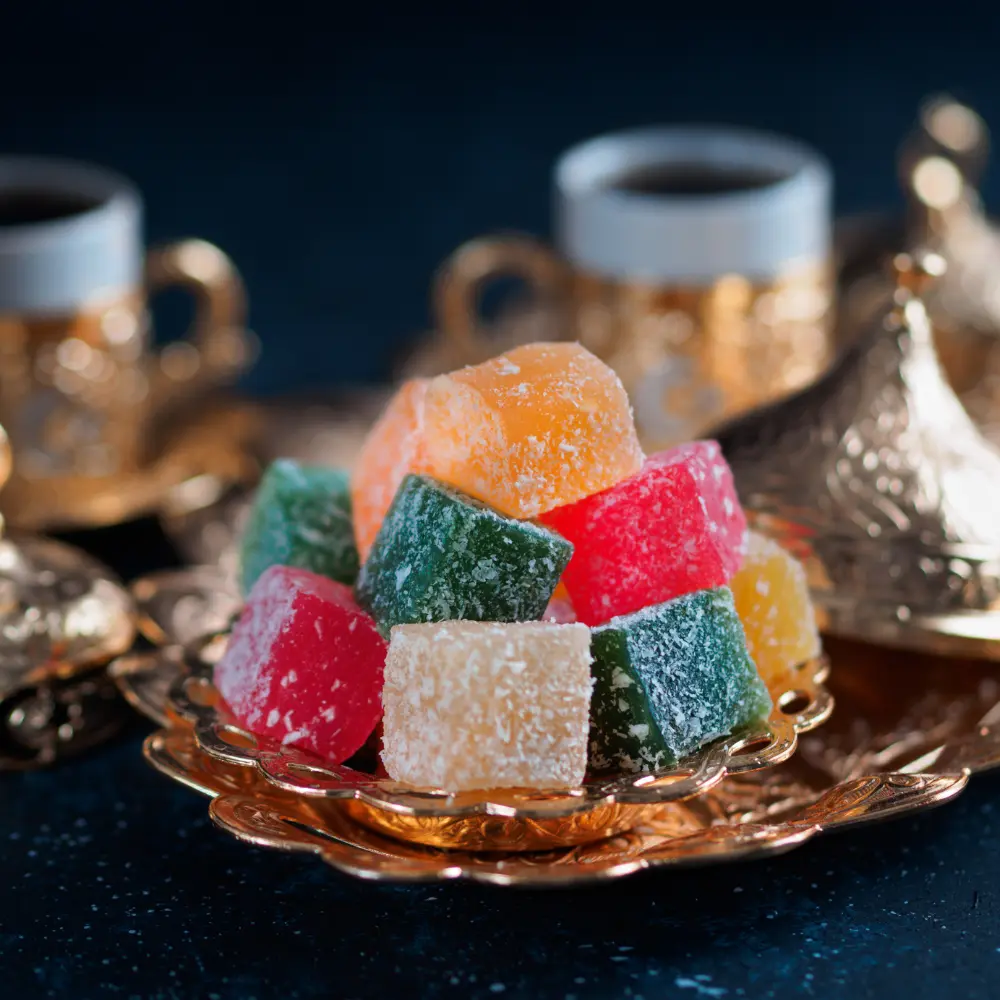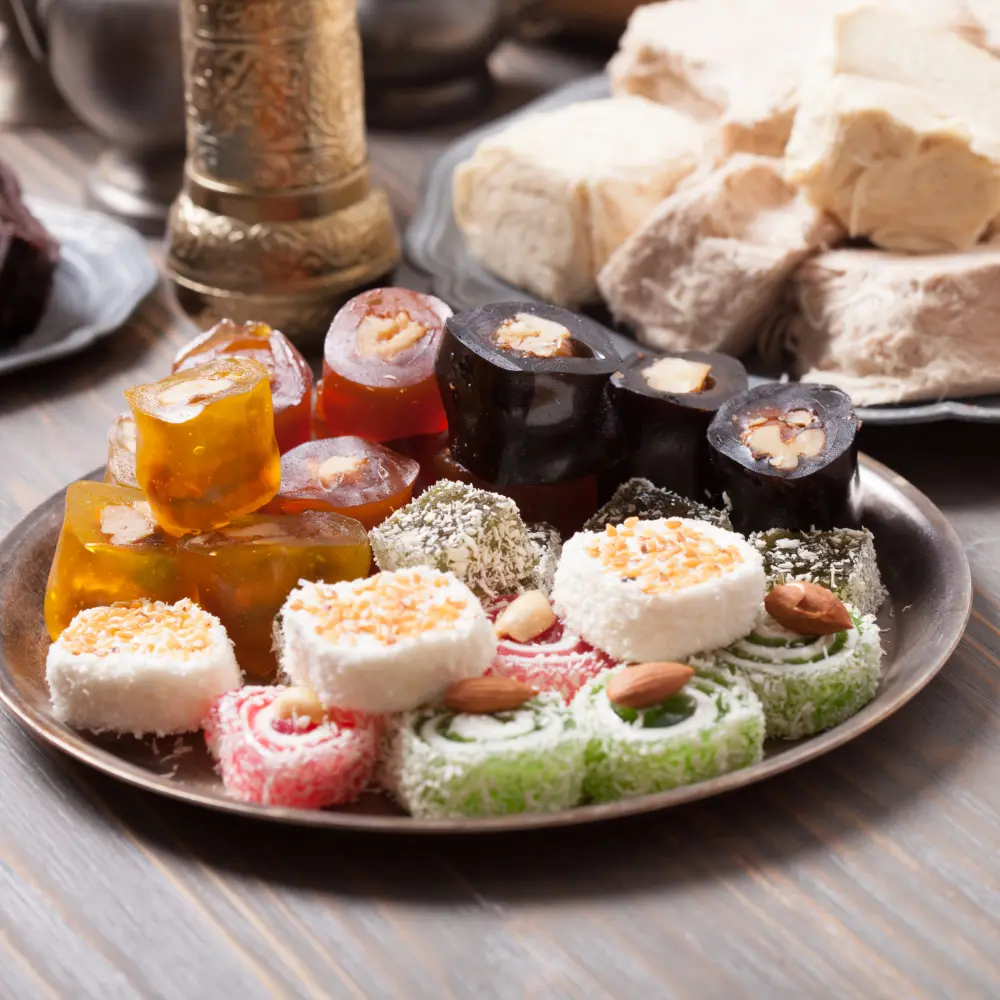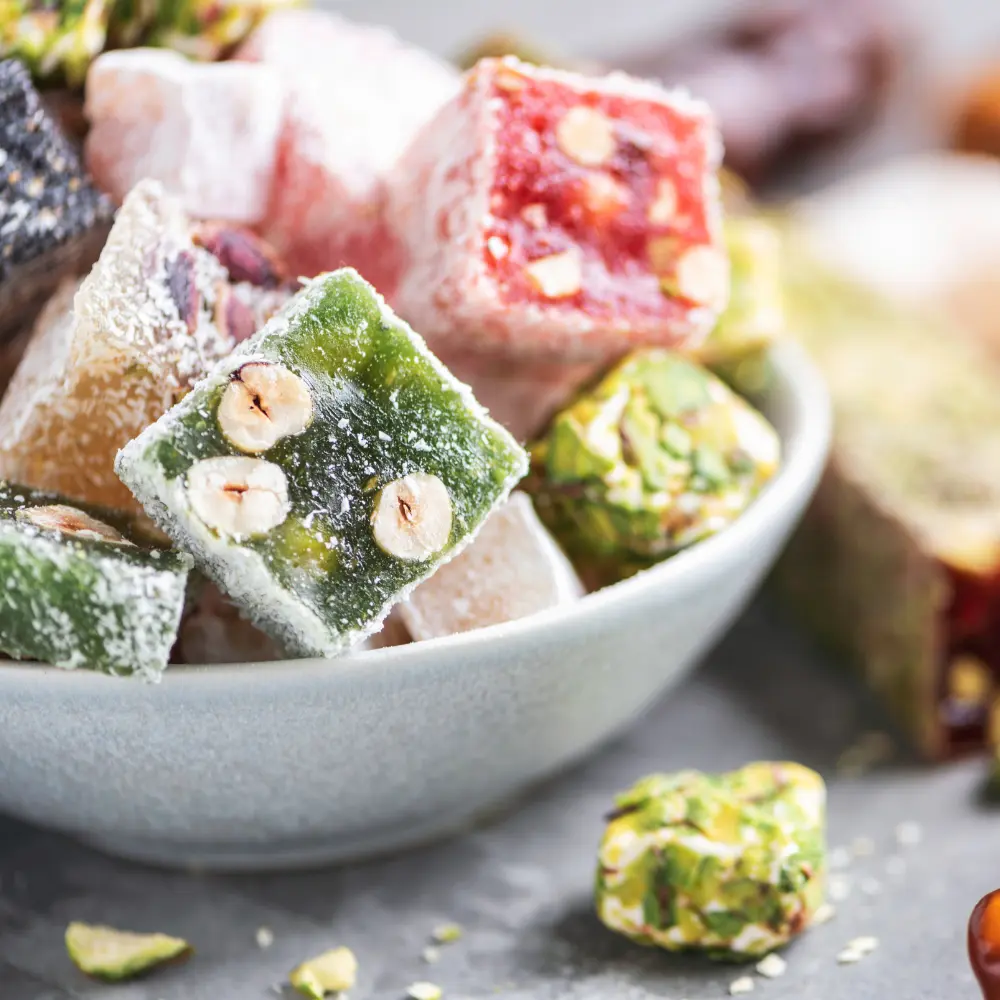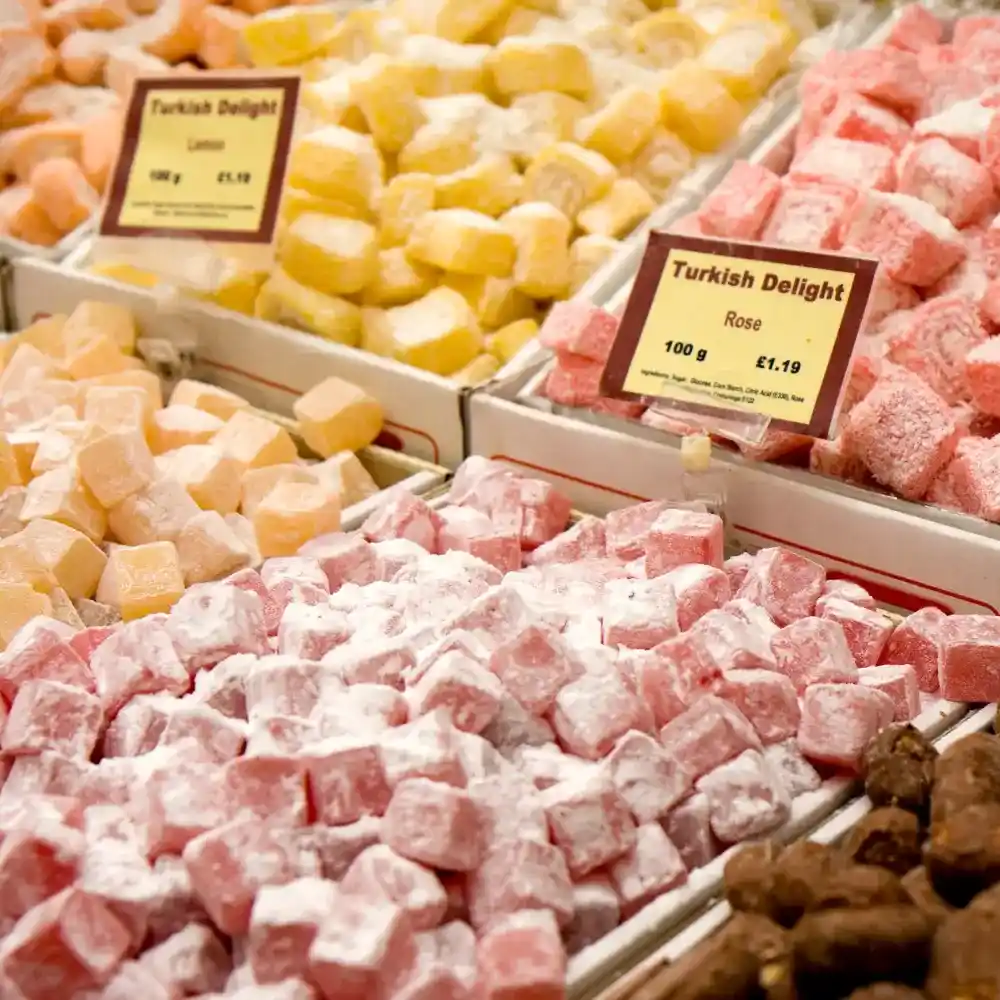The allure of a steaming cup of coffee, its rich aroma wafting through the air, is a universally familiar one. However, when paired with a confection as exotically sweet as the Turkish Delight, it morphs into an ethereal gastronomic experience that transcends borders. Welcome to our exploration of the art of coffee and Turkish Delight – a delightful fusion that promises to awaken your senses.
You may be asking yourself, what is Turkish Delight? This delightful confection, also known as Lokum, originates from Turkey and consists of a gel made from starch and sugar. Discover the flavors and traditions behind this beloved treat today! This age-old candy comes in various flavors, often with a dusting of icing sugar to balance its sweetness. It’s not merely a treat; it’s a piece of cultural heritage that has been passed down through generations, just like the tradition of coffee brewing.
Turkish Delight candy, with its soft, chewy texture and myriad flavors, offers a distinctive contrast to the robust, slightly bitter taste of coffee. Together, they create a unique pairing that strikes a delightful balance between sweetness and bitterness, softness and intensity. Let’s embark on this journey to unravel the enchantment behind this pairing, delving deep into their origin stories, cultural significance, taste profiles, and the impact they have made on a global scale.
So sit back, sip your coffee, take a bite of your Turkish Delight, and join us as we traverse through the enchanting world of these culinary gems.
Coffee and Turkish Delight: Key Takeaway
- A Rich Historical Brew: Coffee and Turkish Delight, or lokum, share rich historical narratives that date back hundreds of years. These two have coexisted and evolved, leaving an indelible mark on many cultures worldwide.
- The Cultural Tapestry: Coffee and lokum are woven into the fabric of many societies. They play significant roles in various rituals and traditions, spanning from the Middle East to the Western world.
- A Symphony of Flavors: The interplay between the robust, bitter flavor of coffee and the sweet, aromatic notes of Turkish Delight creates a unique gustatory experience. Their combined flavors can take your taste buds on an exhilarating journey.
- DIY Delight: Making Turkish coffee and Turkish Delight at home is an achievable feat with the right guidance. Not only can you create these delicacies yourself, but you can also experiment with pairing them to suit your palate.
- Impact Beyond Taste: Coffee and lokum have significant economic, environmental, and ethical implications. Embracing fair trade practices and ethical sourcing can help support a more sustainable and equitable global food system.
The Origin Stories
The world of food and drink is steeped in history, each dish and beverage having its unique tale of discovery and evolution. This journey to the past is especially crucial when we consider favorites like coffee and Turkish Delight candy. Let’s explore the origins of these two beloved staples and discover how their pairing came to be.
The History of Coffee
Coffee, the aromatic beverage that fuels our mornings and invigorates our afternoons, has roots that date back to the 15th century in the Sufi monasteries of Yemen. Its journey to the present day began with the humble coffee plant, Coffea Arabica, native to Ethiopia. Legend tells us of a goat herder named Kaldi who noticed the energetic behavior of his goats after they consumed berries from a certain plant. (1)

From Ethiopia, the practice of brewing coffee traveled across the Arabian Peninsula and soon gained popularity throughout the Middle East, Persia, and Turkey. By the 16th century, coffee houses, known as “qahveh khaneh,” began appearing, becoming hubs of social activity and communication. Eventually, coffee found its way to Europe in the 17th century, causing significant controversy before becoming the beloved beverage it is today. (2)
The Birth of Turkish Delight
Turkish Delight, or Lokum, is a sweet candy that traces its roots back to the Ottoman Empire of the 18th century. A confectioner named Bekir Effendi, who came to Istanbul from a small town in Anatolia, is credited with creating this delightful confection. (3)

Turkish Delight candy is traditionally made with starch, sugar, and a variety of flavors, including rosewater, lemon, or mastic. The sweet is then dusted with icing sugar or copra, giving it its characteristic finish. Turkish Delight quickly gained popularity among the elite of Ottoman society and eventually spread across Europe, becoming an integral part of confectionery traditions in various cultures.
How the Pairing Came to Be
The pairing of coffee and lokum may seem unusual to some, but in reality, it’s a match made in gastronomic heaven. Coffee, with its intense, slightly bitter taste, balances out the sweetness of the Turkish Delight candy beautifully.

Historically, both coffee and Turkish Delight hold a place of significance in Turkish hospitality and are often served together. The tradition of offering guests a cup of Turkish coffee accompanied by a piece or two of Turkish Delight is an enduring one, dating back centuries. It is a symbol of the warm welcome and generosity that Turkish people are known for.
Over time, this pairing was embraced by other cultures, too. Many enjoy the contrast of flavors and textures, the jolt of caffeine tempered by the soothing sweetness of the Turkish Delight. Today, it’s not uncommon to see this delightful duo served together in coffee houses and restaurants around the globe.
The Cultures Behind the Flavors
Coffee and lokum candy as it is known in Turkey, aren’t merely food items. They are vessels of tradition, representing diverse cultures and their unique practices. Let’s embark on a journey exploring the various cultures behind these flavors and their shared rituals.
Coffee Culture Worldwide
The aroma of brewing coffee is a universal language, enjoyed and understood around the globe. Every nation has its coffee-drinking traditions that reflect its culture and way of life.

In Italy, for instance, coffee is synonymous with espresso shots taken at the bar counter in the morning. In Vietnam, coffee is often enjoyed with sweetened condensed milk, a remnant of French colonial influence. Ethiopian coffee ceremonies signify respect and friendship, while in Sweden and Finland, the concept of ‘fika’ or coffee break is central to work-life balance, often accompanied by pastries. (4)
In the United States, coffee has become a part of the daily routine for many, often enjoyed on the go in large takeaway cups. Meanwhile, the Australian and New Zealand coffee cultures place a significant emphasis on the artistry of coffee, from latte art to the precision of the brew.
The Role of Turkish Delight in Middle Eastern Tradition
Lokum candy, more widely known as Turkish Delight, plays a significant role in Middle Eastern culture. The candy is deeply intertwined with various traditions and celebrations, including religious holidays like Eid and social gatherings.

In Turkish culture, Lokum is more than a sweet treat. It symbolizes hospitality, friendship, and refinement. Offering a piece of Turkish Delight to a guest is seen as a gesture of welcome and warmth. It’s also customary to serve Turkish Delight at weddings and birth celebrations, often wrapped in delicate lace and adorned with a small piece of jewelry.
The Shared Rituals of Coffee and Turkish Delight
The shared rituals involving coffee and lokum provide a glimpse into the vibrant traditions of Turkish culture. One of the most widely practiced rituals is the Turkish coffee fortune-telling or ‘tasseography’. After finishing their cup, the person places the saucer on top, makes a wish, and turns it upside down. Once the coffee grounds dry, the patterns they form are interpreted to reveal the person’s fortune. This reading is typically done amidst lively conversation and, of course, some Turkish Delight to sweeten the experience. (5)

As discussed earlier, in Turkey and many other Middle Eastern cultures, serving coffee with a piece of lokum candy is a sign of hospitality. It is a beautiful ritual of togetherness and warmth, a tradition that transcends time and continues to bind communities together. The bitter taste of coffee, coupled with the sweet, chewy texture of Turkish Delight, creates a harmony of flavors that is enjoyed not just for its taste but also for the rich cultural heritage it symbolizes.
The Science of Taste: Coffee and Turkish Delight
The magic of food lies in the way flavors meld together, teasing our taste buds and making us yearn for more. The pairing of coffee and lokum, is a perfect example of this gastronomic alchemy. To fully appreciate this dynamic duo, we need to delve into the science of their taste profiles and how they interact with each other.
Understanding the Flavor Profile of Coffee
The complexity of coffee’s flavor is what makes it such a universally loved beverage. Depending on its origin, roast level, and brewing technique, the flavor profile of coffee can range from fruity and floral to chocolatey and nutty. It has an inherent bitterness due to the presence of compounds like chlorogenic acid and caffeine, but it’s this very bitterness that gives coffee its characteristic depth of flavor.

Turkish coffee, a variety enjoyed widely, is known for its intense flavor and unique preparation. The coffee beans are ground to a fine powder and simmered in a special pot known as ‘cezve’, usually with sugar. The result is a strong, rich coffee, which often leaves a thick layer of ‘mud’ or sludge at the bottom of the cup. (6)
The Sweet Complexity of Turkish Delight
Turkish Delight, or lokum, is a beautifully sweet and slightly chewy confection. The basic recipe for this treat involves a gel of starch and sugar, giving it a unique texture that’s both soft and firm. This sweetness is often balanced by the addition of flavors such as rosewater, lemon, and even mastic, an aromatic resin.

But lokum’s complexity doesn’t end there. Some versions of this candy are filled with nuts or dried fruits, adding a delightful crunch and a new layer of flavor to each bite. As mentioned before, the finishing touch is often a dusting of powdered sugar, adding a slight grittiness that contrasts with the smooth gel inside.
The Synergy of Coffee and Turkish Delight in Your Palate
As discussed earlier the pairing of coffee, particularly the strong, rich Turkish coffee, and the sweet Turkish treat creates a delightful dance of flavors on your palate. The bitter notes of the coffee helps cut through the sweetness of the treat, providing a balance that enhances the flavors of both.

This balance is key to the success of this pairing. The bitterness of the coffee stimulates the taste receptors at the back of the tongue, while the sweetness of the lokum candy engages the receptors at the tip. This full-tongue engagement makes the experience of savoring coffee and Turkish Delight a rich, satisfying one.
In essence, the artful pairing presents a harmonious blend of taste and texture, bitterness and sweetness, softness, and intensity. Whether you’re savoring this combination as a daily ritual or a special treat, the symphony of flavors and the richness of the cultural history behind them make for a truly delightful gastronomic journey.
Brewing and Making: A DIY Guide

As we delve deeper into the fascinating world of coffee and lokum, it’s only natural that we’d want to recreate this experience at home. This DIY guide will help you brew the perfect cup of coffee, teach you how to make Turkish Delight, and provide useful tips for pairing these two together.
A Guide to Brewing the Perfect Cup of Coffee
Making a good cup of coffee is an art form that requires precision and understanding of the process.
Choosing the Right Coffee Beans
Firstly, you need to choose your coffee beans. For Turkish coffee, Arabica beans are often preferred due to their superior taste and aroma. These beans should be ground to a very fine powder – almost like the consistency of flour.
Essential Equipment for Turkish Coffee
Secondly, you need the right equipment. Turkish coffee is traditionally made in a small, narrow-necked pot known as a ‘cezve’. For the best results, it’s advisable to use copper cezves, which are considered the best Turkish coffee pots due to their superior heat conductivity.
Brewing Turkish Coffee: Measuring and Heating
To make Turkish coffee, measure out one cup of water into your cezve for each serving. Add one to two heaped teaspoons of your coffee grounds and sugar to taste. Place the cezve over low heat and stir gently until the sugar is dissolved. Allow the coffee to heat slowly without stirring. When the coffee starts to froth up, remove it from the heat just before it boils over.
Serving Turkish Coffee with Flair
Pour a little of the froth into each coffee cup, then return the cezve to the heat. Repeat this process a couple more times until your coffee has frothed up two or three times in total. After the final frothing, pour the remaining coffee into the cups, ensuring that each one gets an equal amount of the coffee and the froth. Be sure to serve it hot.
Making Your Own Turkish Delight at Home
Homemade Turkish Delight or lokum is a treat that’s worth the effort. The basic recipe for this treat involves sugar, cornstarch, cream of tartar, rosewater, and a coating of powdered sugar.

Start by creating a sugar syrup by boiling sugar and water, then add a mixture of cornstarch and cream of tartar to form a thick paste. This mixture is then cooked over low heat until it becomes golden and thick. The rosewater is added towards the end of cooking.
Once your treat mixture is ready, it’s poured into a square dish and left to set overnight. The final step involves cutting the set mixture into cubes and dusting them with powdered sugar to prevent sticking. This is the basic method on how to make this treat. Variations of the recipe may include the addition of nuts or different flavorings.
Pairing Tips for Coffee and Turkish Delight
Pairing coffee with the Delight involves finding the right balance between the bitter notes of the coffee and the sweet, aromatic flavors of the treat.
If you’re serving a robust, full-bodied Turkish coffee, pair it with a delicately flavored rose or lemon Turkish Delight. The subtle lokum flavors won’t compete with the coffee and will provide a sweet counterpoint to the coffee’s intensity.
On the other hand, if you’re serving a lighter coffee, don’t be afraid to pair it with a more boldly flavored Turkish Delight, such as one filled with pistachios or flavored with pomegranate.
Remember, the key to the perfect pairing is balance, so don’t be afraid to experiment and find the combination that delights your palate the most.
The Global Impact of Coffee and Turkish Delight
The cultural significance of coffee and lokum has helped them become integral elements of the global food industry. As we explore their economic, environmental, and ethical impact, we gain an even greater appreciation for these two delights.
The Coffee Industry: Economics and Environmental Aspects
Coffee is one of the most widely traded agricultural commodities worldwide, with millions of people depending on its cultivation and trade for their livelihoods. It significantly contributes to the economies of several developing countries, providing employment and income to countless families.
However, coffee production also has notable environmental implications. The growing demand for coffee has led to significant deforestation in many parts of the world, as forests are cleared to make way for coffee plantations. Furthermore, the use of chemical fertilizers and pesticides in coffee cultivation can lead to water pollution and soil degradation. (7)
On the brighter side, more and more coffee growers and businesses are adopting sustainable farming practices, recognizing the importance of preserving the environment while meeting the global demand for coffee. From shade-grown coffee, which reduces deforestation, to organic farming methods that eliminate the use of harmful chemicals, these practices are slowly transforming the industry.
The Turkish Delight Market: Past, Present, and Future
Turkish Delight, or lokum, has a longstanding history dating back hundreds of years. Its fame has spread far beyond the borders of Turkey, and it has become a global phenomenon in its own right.
The market for Turkish Delight has seen considerable growth over the years. It is now an integral part of the confectionery market in many countries, appreciated not just for its delicious taste but also for its rich cultural significance.

Looking toward the future, the Turkish Delight market is expected to continue its growth. With increasing global interest in diverse food cultures and growing demand for unique, artisanal sweets, Turkish Delight is well-positioned for ongoing popularity.
Fair Trade and Ethical Considerations in the Coffee and Turkish Delight Industries
In an increasingly conscious global market, fair trade and ethical considerations play a pivotal role. Fairtrade practices ensure that farmers and workers involved in the production process receive fair wages and work under safe conditions.

The coffee industry, in particular, has seen a significant push towards fair trade practices. Many companies now offer fair-trade coffee, contributing to better working conditions and fairer trade terms for coffee farmers.
In the Turkish Delight industry, ethical considerations mainly revolve around sourcing and production practices. As the demand for lokum continues to grow, it’s crucial to ensure that the ingredients used in Turkish Delight production, such as sugar, are sourced ethically.
In both industries, the move towards more ethical and sustainable practices not only benefits those involved in the production process but also results in a higher-quality product. As consumers, choosing fair trade coffee and ethically produced Turkish Delight allows us to enjoy these delicious treats while also supporting a more sustainable and equitable global food system.
The Silver Screen Stardom of Turkish Delight
In the world of popular culture, Turkish Delight has carved its own sweet niche, making guest appearances that have left indelible marks on audiences worldwide. This aromatic confectionery has tantalized taste buds not only in reality but has also mesmerizingly made its way into fictional realms, making it a starlet in its own right.

Turkish Delight’s most famous cameo might well be in C.S. Lewis’s ‘The Chronicles of Narnia’. The “sweet and delicious” lokum was used as a plot device, beguiling young Edmund into betraying his family for an endless supply of this treat. This unforgettable scene catapulted Turkish Delight into the global limelight and forever etched the candy into the minds of countless readers and later, movie-goers.
In a testament to its cinematic appeal, this treat continues to grace both the silver and small screens, in everything from historical dramas to contemporary comedies. Its vibrant colors, delicate texture, and connection to a rich cultural heritage make it a fascinating and versatile addition to any storyline.
Turkish Delight, while delightful in its own right, has thus transcended its candy status and become a symbol of temptation, a vessel of cultural exchange, and an icon in the world of popular culture. Its on-screen allure only adds another layer to our appreciation of this historic treat, bridging the gap between reality and imagination in the sweetest way possible.
Conclusion
In conclusion, the harmonious coupling of coffee and Turkish Delight – the beloved lokum – creates a delightful fusion of flavor, culture, and history. The journey of what is Turkish Delight and its accompanying coffee is a tale spanning continents and centuries, weaving through bustling markets and quaint coffee shops, and leaving its sweet, aromatic trail in literature and cinema.
As we have explored in this article, this pairing is not just about indulging the senses. It’s about understanding the rich tapestry of cultural traditions, the significant impact on global economies, and the important environmental and ethical considerations behind each cup of coffee and piece of Turkish Delight candy.
Our expedition into the world of coffee and Turkish Delight is a testament to their transcendent charm. Whether you are savoring the comforting bitterness of a well-brewed coffee or melting into the sweet, chewy ecstasy of a piece of Turkish Delight, you are participating in a global ritual – one steeped in tradition, diversity, and shared delight.
So, the next time you relish the taste of Turkish Delight with a cup of coffee, remember that you are not just enjoying a delicious combination, you are taking a bite and a sip of history, and becoming part of a delightful, ongoing narrative.
FAQ
How are coffee and Turkish delight part of different cultures?
Coffee and Turkish delight are deeply rooted in many cultures, representing hospitality in the Middle East, forming an integral part of Turkish and Middle Eastern rituals, and being globally appreciated as indulgences.
What is the flavor synergy between coffee and Turkish delight?
The robust, bitter taste of coffee contrasts beautifully with the sweet, aromatic flavors of Turkish Delight, creating a delightful balance on the palate.
How can I make and pair my own coffee and Turkish delight at home?
With a detailed guide and the right ingredients, you can brew the perfect cup of coffee and make your own Turkish Delight. Experiment with different flavors of coffee and Turkish Delight to find your perfect pairing.
What is the global impact of the coffee and Turkish delight industries?
Coffee and Turkish Delight industries significantly contribute to the global economy but also pose environmental and ethical challenges. A shift towards fair trade practices and sustainable farming methods is influencing positive change.




















